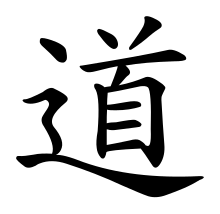Fuji (planchette writing)
Fuji (Chinese: 扶乩/扶箕; pinyin: fújī; Wade–Giles: fu chi) is a method of "planchette writing", or "spirit writing", that uses a suspended sieve or tray to guide a stick which writes Chinese characters in sand or incense ashes.[1]
| Part of a series on |
| Taoism |
|---|
 |
|
Practices
|
|
Deities |
|
Organisations |
Development
Beginning around the Ming Dynasty (1368-1644 CE), the fuji method and written characters changed from 扶箕 "support the sieve" (spirit-writing using a suspended sieve or winnowing tray) to 扶乩 "support the planchette" (directing a stick or stylus, typically made from a willow or peach branch, and roughly resembling a dowsing-rod).
Vocabulary
Chinese fuji spirit-writing involves some specialized vocabulary. Luan (鸞) "a mythical phoenix-like bird" is used in synonyms such as fuluan (扶鸞, "support the phoenix"), feiluan (飛鸞 "flying phoenix," and jiangluan (降鸞, "descending phoenix"). The fuji process involves specialized participants. The two people (or rarely one) who hold the sieve or stylus are called jishou (乩手, "planchette hands"), only one of whom is ostensibly possessed by a shen (神, "spirit; god") or xian (仙, "immortal; transcendent"). Their assistants include a pingsha (平沙, "level sand") who smooths out the shapan (沙盤, "sand table"), a dujizhe (讀乩者, "planchette reader") who interprets the characters, and a chaojizhe (抄乩者, "planchette copyist") who records them. Jiwen (乩文, "planchette writing") is a general reference to texts produced through Chinese fuji spirit-writing.
Folk history
Spirit-writing has a long history in Chinese folk religion, and is first recorded (Chao 1942:12) during the Liu Song Dynasty (420-479 CE). Fuji planchette-writing became popular during the Song Dynasty (960-1279), when authors like Shen Kuo and Su Shi associated its origins with summoning Zigu (紫姑, "Purple Maiden"), the Spirit of the Latrine. Fuji divination flourished during the Ming Dynasty, and the Jiajing Emperor (r. 1522-1566) built a special jitan (乩壇, "planchette altar") in the Forbidden City (Despeux 2007:428). Although the practice of fuji planchette-writing was prohibited by the Qing Dynasty (1644-1912) Legal Code, it has continued and is currently practiced at Daoist temples in Taiwan, Hong Kong, and Malaysia as well as folk shrines in China.
Uses
Fuji is particularly associated with the Quanzhen School of Daoism. The Daozang "Daoist Canon" contains several scriptures supposedly written through spirit-writing. Two examples are the Zitong dijun huashu (梓潼帝君化書, "Book of Transformations of the Divine Lord of Zitong").
See also
References
- Chao, Wei-pang (1943). The Origin and Growth of the Fu Chi. Nanzan Institute for Religion and Culture: Asian Ethnology Vol. 2. pp. 9–27. Retrieved 10 May 2017.
Further reading
- de Groot, J.J.M. 1910. "Spirit-Writing, and other Oracular Work", in The Religious System of China, 6:1295-1316, E.J. Brill.
- Wilhelm, Richard. 1931. The Secret of the Golden Flower: A Chinese Book of Life. Harcourt Brace.
- Jordan, David K. and Daniel L. Overmyer. 1986. The Flying Phoenix: Aspects of Chinese Sectarianism in Taiwan. Princeton University Press.
- Russel, Terence C. 1990. "Chen Tuan at Mount Huangbo: A Spirit-writing Cult in Late Ming China", Asiatische Studien/Études Asiatiques 44.1:107-140.
- Kleeman, Terry F. 1994. A God's Own Tale: The Book of Transformations of Wenchang, the Divine Lord of Zitong. State University of New York Press.
- Lang, Graeme and Lars Ragvald. 1998. "Spirit-writing and the Development of Chinese Cults", Sociology of Religion 59.4:309-328.
- Clart, Phillip. 2003. "Moral Mediums: Spirit-Writing and the Cultural Construction of Chinese Spirit-Mediumship", Ethnologies 25.1:153-190.
- Despeux, Catherine. 2007. "Fuji 扶乩 planchette writing; spirit writing," in The Encyclopedia of Taoism, ed. Fabrizio Pregadio, Routledge, 428-429.
External links
| Wikisource has original text related to this article: |
- Planchette writing (Fuji), Taoist Culture & Information Centre
- Spirit-writing and Hakka Migration in Taiwan – A Case Study of the Canzan Tang 參贊堂 in Puli 埔里, Nantou 南投 County, Paul R. Katz
- Ancient Ouija Boards: Fact or Fiction?, Museum of Talking Boards
- (in Chinese) 宗旨, Fuji Altar at Kam Lan Koon 金蘭觀, Hong Kong
- (in Chinese) 紫瑞乩文, Fuji Altar at Che Sui Khor, Malaysia
- (in Chinese) 道慈研究, Fuji at 世界紅卍字會臺灣總主會, Taiwan